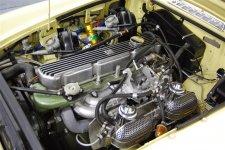Found “Fran” Hernandez most famous phot the other day...,




In relation to the idea that its not about total airflow...
That got me thinking...
Year ago, Australlian Group C, Group A and then AVESCO racer Larry Perkins let Group A racers know a little secret. That his 4-bbl Quadrajet 304 cube racer made 460 hp at 6500 rpm, and it beets 462 hp at 6700 rpm. That got me thinking that true induction index of performance or efficency is when you make the maximum amount of power with the least revs for a given capacity. Many have used this before, but its "capacity, multiply it by revs at maximum power, then divide it by maximum power"
You get an Aspirations Index. The lower the number, the more efficent the engine is. In imperial, its (Cubic Inch Displacement*RPM) divided by flywheel net BHP. In metrics its (cc3 displacement*rpm)/kw.
There would be few that argue that on a revs per minute, per cubic inch basis, the old one throttle per two cylinder NASCAR 355 V8's make just about more power than just about anything gasoline powered without nitrous, a turbo, blower, or rocket fuel. 850 Bhp at 900 RPM from 358-cubic-inches is 3790. If you make 750 bhp net at 16000 rpm from 146 cubic inches, thats an Aspirations Index of 3114. I'm sure if a NASCAR had quad cams, air valves and fully interated spark and engine managment, it'd do 3000 Aspirations index.
One of the most effiecnt engines is the 109 mph, 1593 pound 1959 Saab 93 XP, 90 bhp at 6500 RPM from 46 cubic inches, an Aspirations Ratio of 3300. It is two stroke, so its not really apples verses apples. But it is a 2-bbl carb driving a 3 cylinder engine.
https://www.youtube.com/watch?feature=p ... _lXG2q4xGw
So both the 390 cfm 4-bbl carbed NASCAR V8s and old LeMans 2 strokes are using the same total cfm of carburation at 1.5"Hg , and getting class winning performance without even F1 style port on port induction. One flowing over 650 hp, the other 90 hp. The big engine has 8 times the capacity, and about 8 times the power with the same size venturis.
And that got me thinking...wouldn't a well fettled 3-bbl I6 do just as well?
I mean, a 2-bbl In line six cylinder TC3000 Argie racer does 390 hp at 9500 rpm from just 183 cubes, an apiration index of only 4457..
A properly optimized area carb barrel might give another 25% more power.
That got me thinking..
Doesn't this Triple Solex 34 W2 manifold throttle body , which supports three 1.14" venuris, just look like it could take the top of three Carter YFA's co joined?.

Four stud base, just perfect for three YFA Carter 1-bbl carbs
If some ones Two Stroke Saab 96 is missing a triple carb. I've got 'em...




In relation to the idea that its not about total airflow...
That got me thinking...
Year ago, Australlian Group C, Group A and then AVESCO racer Larry Perkins let Group A racers know a little secret. That his 4-bbl Quadrajet 304 cube racer made 460 hp at 6500 rpm, and it beets 462 hp at 6700 rpm. That got me thinking that true induction index of performance or efficency is when you make the maximum amount of power with the least revs for a given capacity. Many have used this before, but its "capacity, multiply it by revs at maximum power, then divide it by maximum power"
You get an Aspirations Index. The lower the number, the more efficent the engine is. In imperial, its (Cubic Inch Displacement*RPM) divided by flywheel net BHP. In metrics its (cc3 displacement*rpm)/kw.
There would be few that argue that on a revs per minute, per cubic inch basis, the old one throttle per two cylinder NASCAR 355 V8's make just about more power than just about anything gasoline powered without nitrous, a turbo, blower, or rocket fuel. 850 Bhp at 900 RPM from 358-cubic-inches is 3790. If you make 750 bhp net at 16000 rpm from 146 cubic inches, thats an Aspirations Index of 3114. I'm sure if a NASCAR had quad cams, air valves and fully interated spark and engine managment, it'd do 3000 Aspirations index.
One of the most effiecnt engines is the 109 mph, 1593 pound 1959 Saab 93 XP, 90 bhp at 6500 RPM from 46 cubic inches, an Aspirations Ratio of 3300. It is two stroke, so its not really apples verses apples. But it is a 2-bbl carb driving a 3 cylinder engine.
https://www.youtube.com/watch?feature=p ... _lXG2q4xGw
So both the 390 cfm 4-bbl carbed NASCAR V8s and old LeMans 2 strokes are using the same total cfm of carburation at 1.5"Hg , and getting class winning performance without even F1 style port on port induction. One flowing over 650 hp, the other 90 hp. The big engine has 8 times the capacity, and about 8 times the power with the same size venturis.
And that got me thinking...wouldn't a well fettled 3-bbl I6 do just as well?
I mean, a 2-bbl In line six cylinder TC3000 Argie racer does 390 hp at 9500 rpm from just 183 cubes, an apiration index of only 4457..
A properly optimized area carb barrel might give another 25% more power.
That got me thinking..
Doesn't this Triple Solex 34 W2 manifold throttle body , which supports three 1.14" venuris, just look like it could take the top of three Carter YFA's co joined?.

Four stud base, just perfect for three YFA Carter 1-bbl carbs
If some ones Two Stroke Saab 96 is missing a triple carb. I've got 'em...







